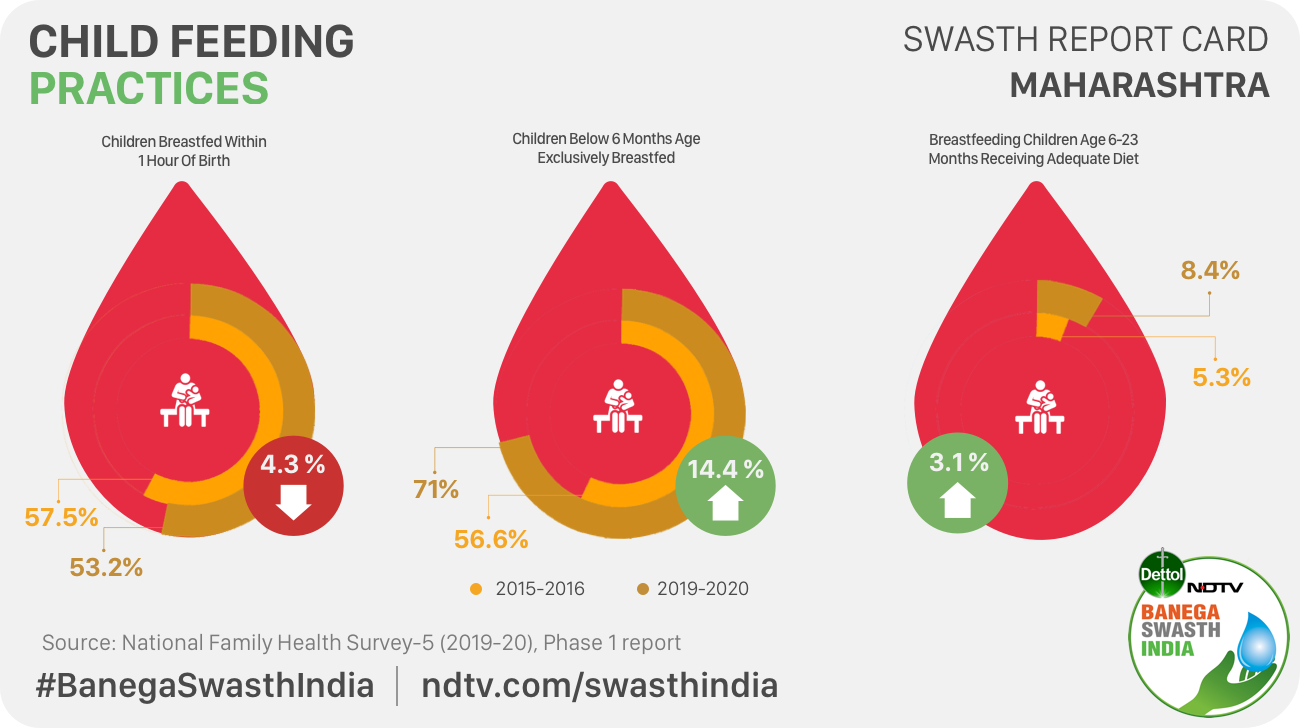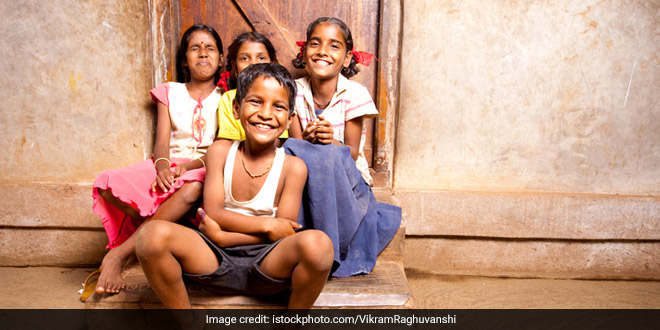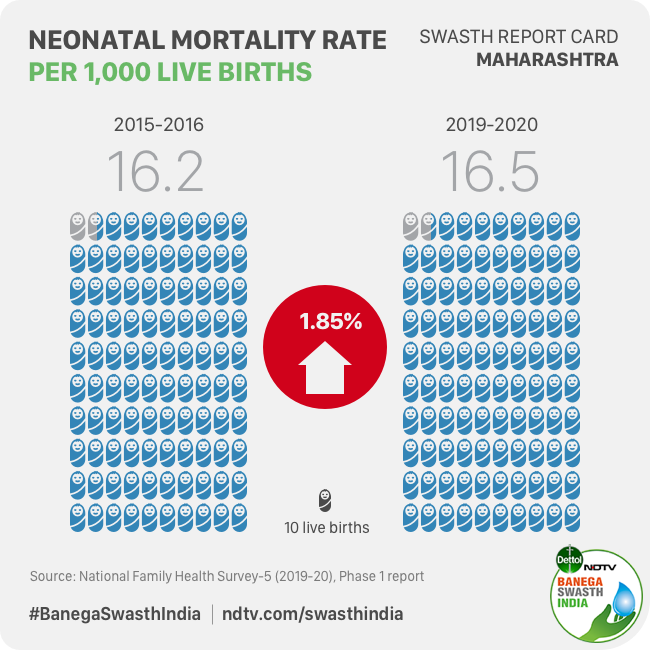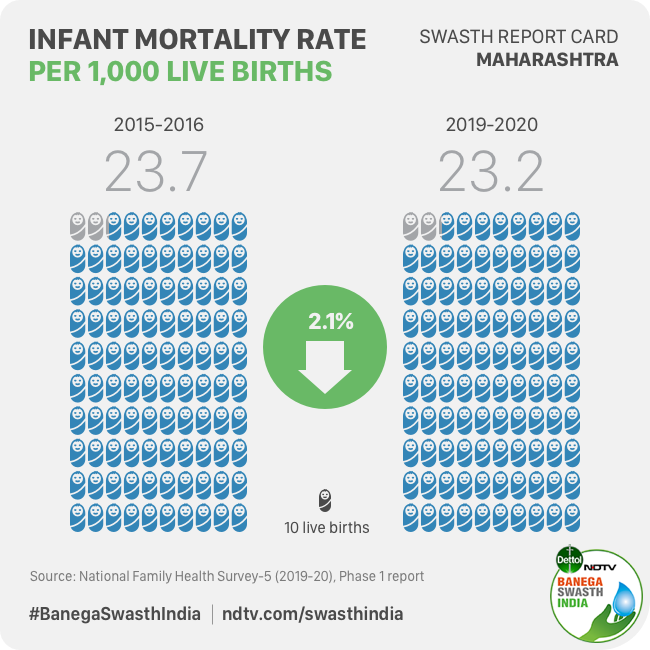Highlights
- Percentage of overweight children has spiked from 1.9 in 2015-16 to 4.1 now
- Child wasting or low weight for height has remained unchanged at 25.6%
- Prevalence of anaemia among women (15-49 years) has also increased
New Delhi: In a recently released data from the first phase of the fifth round of National Family Health Survey (NFHS-5) covering 17 states and five union territories, Maharashtra has shown little to no improvement in key health indicators like infant and child mortality, malnutrition and anaemia. According to the report released by Union Health Ministry on December 13, last year, neonatal mortality rate that is the number of children dying within 28 days of birth has increased since the last NFHS conducted in 2015-16. Similarly, the nutritional status of children is not very encouraging as the prevalence of overweight and stunted (low height for age) children have increased significantly. A rise in levels of anaemia among children, women and men in Maharashtra is also a cause of worry. However, child immunisation, menstrual hygiene practises and access to drinking water and sanitation has improved.
Here’s a look at Maharashtra’s performance in terms of health parameters:
Infant And Child Mortality Rate
Neonatal Mortality Rate: The first 28 days of life are called a neonatal period. According to the National Family Health Survey (NFHS-5) conducted in 2019-20, the neonatal mortality per 1,000 live births is 16.5 as opposed to 16.2 deaths per 1000 live births in 2015-16. The state has seen a rise of 1.85 per cent in neonatal mortality when compared to the data of NFHS-4.
Infant Mortality Rate: The number of children dying under the age of one per 1,000 live births has come down in Maharashtra from 23.7 deaths in 2015-16 to 23.2 deaths now. The state has reported a drop of 2.1 per cent.
Under-five Mortality Rate: NFHS-5 shows that the U5MR of the state is at 28, about 2.43 per cent down from its NFHS-4 data when the U5MR was 28.7 deaths per 1,000 live births.
Increased Immunisation
According to the survey, the state has reported an improvement in full vaccination coverage among children aged 12-23 months, among those surveyed. Child vaccination has increased from 56.2 per cent in NFHS-4 to 73.5 per cent in NFHS-5. According to the Ministry of Health and Family Welfare, full immunisation implies vaccinating children with BCG (Bacille Calmette-Guerin) which is a vaccine for tuberculosis (TB), vaccines to prevent measles – MMR (measles, mumps, and rubella) and three doses each of polio (excluding polio vaccine given at birth) and DPT (diphtheria, pertussis, and tetanus).

Maharashtra has reported an improvement in full vaccination coverage among children aged 12-23 months
Also Read: How To Safely Vaccinate Children During COVID-19 Pandemic
Status Of Child Feeding Practices
WHO (World Health Organization) recommends initiating breastfeeding within the first hour of the birth of a child. NFHS-5 data shows that among the children surveyed in Maharashtra, breastfeeding in the first hour of birth has shown a downward trend when compared to the data recorded under the NFHS-4. 53.2 per cent of the children were breastfed within one hour of the birth in 2019-20 whereas 57.5 per cent were breastfed in 2015-16.
However, 14.4 per cent increase in children exclusive breastfed till completion of 6 months is encouraging.
The state has also recorded an improvement in the proportion of breastfeeding children age 6-23 months receiving an adequate diet from 5.3 per cent in 2015-16 to 8.4 per cent in 2019-20.

While early initiation of breastfeeding has declined in Maharashtra, the percentage of children exclusively breastfed for first six months has improved
Malnutrition, Especially Sudden Rise In Obesity Among Children Is Worrying
Malnutrition is a medical condition caused due to an unbalanced diet that has deficiencies, excesses or imbalance in a person’s intake of one or more vital nutrients. The word malnutrition is an umbrella term covering underweight, child stunting, child wasting, micronutrient related deficiencies and overweight or obesity.
Child stunting and the percentage of underweight children in Maharashtra has increased. According to NFHS-4, the prevalence of stunting or low height for age among children under the age of five years has seen an increase from 34.4 per cent in 2015-16 to 35.2 per cent in 2019-20. Children under five who are underweight have increased marginally by 0.1 per cent.
Child wasting or low weight for height has remained unchanged at 25.6 per cent. But the prevalence of children who are severely wasted have recorded a growth of 1.5 per cent.
What’s alarming is the 2.2 per cent rise in the children who are overweight. As per NFHS-5, in 2015-16, 1.9 per cent of the children under five years of age in the state were overweight. However, in 2019-20, the percentage has jumped to 4.1 per cent.
Also Read: Policy Makers Need To Focus On The First 1,000 Days Of Life: Experts React To NFHS-5 Survey Trends
Talking about the nutritional status of children of Maharashtra, Dr Sujeet Ranjan, Executive Director, The Coalition for Food and Nutrition Security (CFNS), New Delhi, said,
The data from NFHS-5 reveals the importance of nutrition more than ever before as the nutrition indicators have not fared well. Institutional births, immunisation, pre and post-natal services have improved but to improve the nutrition indicators community based care approaches are more pertinent. To effectively carry out community based approaches to child care, community mobilisation and community engagement is much needed. Nutrition specific and sensitive interventions should be targeted to reduce multiple forms of malnutrition.
Further elaborating on the steps needed to eradicate malnutrition and improve the nutritional status of children, Dr Ranjan said,
The strategies to ensure food security, including dietary diversity and access to adequate micronutrients, primary health care, safe drinking water, environmental, household sanitation and address gender issues pertaining to women’s education, gender based violence and delaying age of conception should be accelerated.
Anaemia Among Children And Adults Records Substantial Growth
While NFHS-4 conducted in 2015-16 reported a decline in anaemia levels, recently conducted NFHS-5 shows an upsurge hinting towards reverse in gains made in the past. Children (6-59 months) with Haemoglobin (Hb) levels less than 11 gm/dl are considered anaemic. As per NFHS-5, anaemia among children (6-59 months) in Maharashtra has recorded a jump of over 15 per cent moving from 53.8 per cent in 2015-16 to 68.9 per cent now.
Women belonging to the age group 15-49 years also seem to be widely affected by anaemia. About 54 per cent of these women are anaemic and there has been a spike of 6.2 per cent from NFHS-4 conducted in 2015-16, when anaemia prevalence was 48 per cent among women in this age group.
Also Read: How Haryana Is Fighting Anaemia And Improving Its Score Under Anaemia Mukt Bharat Campaign
According to the experts, if a woman is anaemic and lives undernourished throughout her life, it is passed on to the baby. Talking about the rise in anaemia among women, which according to Dr Ranjan is a major cause of concern, he said,
In all the states, anaemia is much higher among women compared to men. The challenges like a lack of trained personnel for counselling in peripheral areas, limited family counselling and male engagement continues. While spousal violence has generally declined in most of the states and UTs, it has witnessed an increase in five states including Maharashtra. Also, if we look at the indicators for gender based violence, in Maharashtra there is a sudden increase, which makes it very clear that it has severe consequences for women and it is not only devastating for survivors of violence and their families, but also entails significant social and economic costs. It requires community-based, multi-pronged approach, and sustained engagements.
The proportion of anaemic men has also increased in the state from 17.7 per cent in 2015-16 to 21.9 per cent in 2019-20. This is an increase of 4.2 per cent.
More Women Are Following Menstrual Hygienic
The state of Maharashtra has reported significant improvement in menstrual hygiene among women between 15 to 24 years of age in 2019-20, compared to NFHS-4. 84.8 per cent of the women surveyed were using hygienic methods of protection during their menstrual period in 2019-20 whereas, in 2015-16, the number stood at 66.1 per cent.
Access To Drinking Water And Sanitation
93.5 per cent of the population surveyed in 2019-20 is living in households with an improved drinking-water source. This is an increase of 1 per cent from NFHS-4 conducted in 2015-16. According to the Union Health Ministry, the sources of drinking water include piped water in the residence or piped to the neighbour, public taps, tube-wells, dug-wells, rainwater, tanker truck, cart with small tank, bottled water, and community RO plant, among others.

Access to improved drinking water and sanitation facilities has increased in the state, as per NFHS-5
Similarly, the percentage of people living in households that use an improved sanitation facility has moved up from 52.3 per cent in 2015-16 to 72 per cent now. Around 20 per cent increase doesn’t denote access to a toilet facility. In fact, it indicates access to flush to piped sewer system, flush to septic tank, flush to pit latrine, twin pit toilet, which is not shared with any other household.
Also Read: Despite Improvements In Health Services, Malnutrition Persists In West Bengal Finds NFHS-5
NDTV – Dettol Banega Swasth India campaign is an extension of the five-year-old Banega Swachh India initiative helmed by Campaign Ambassador Amitabh Bachchan. It aims to spread awareness about critical health issues facing the country. In wake of the current COVID-19 pandemic, the need for WASH (Water, Sanitation and Hygiene) is reaffirmed as handwashing is one of the ways to prevent Coronavirus infection and other diseases. The campaign highlights the importance of nutrition and healthcare for women and children to prevent maternal and child mortality, fight malnutrition, stunting, wasting, anaemia and disease prevention through vaccines. Importance of programmes like Public Distribution System (PDS), Mid-day Meal Scheme, POSHAN Abhiyan and the role of Aganwadis and ASHA workers are also covered. Only a Swachh or clean India where toilets are used and open defecation free (ODF) status achieved as part of the Swachh Bharat Abhiyan launched by Prime Minister Narendra Modi in 2014, can eradicate diseases like diahorrea and become a Swasth or healthy India. The campaign will continue to cover issues like air pollution, waste management, plastic ban, manual scavenging and sanitation workers and menstrual hygiene.
[corona_data_new]




































